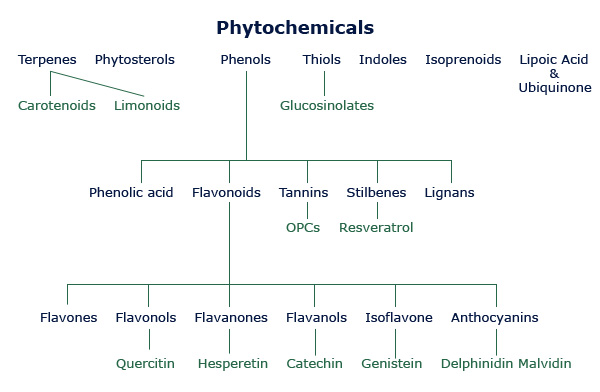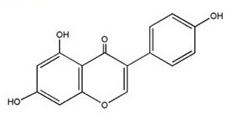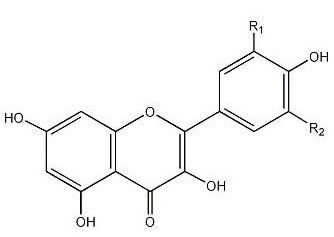Phytochemicals: Foundational to Health
|
Dear Friends,
What is becoming a renaissance of awareness within the practice of medicine is the acknowledgement that colorful fruits and vegetables have much to offer for health building and disease prevention. It is all available to us through their multitude of phytochemicals. Last week I diagramed the various categories within phytochemicals. This week I want to deepen our understanding of these categories. Remembering that function follows structure, I will set the stage for our functional discussions (next week) of the individual phytochemical by first looking at their structure. Below are the molecular structures for the Flavonoids, a subgroup within the Phenols. Notice their structural similarities and differences. We will see how these structures affect their biological performances as antioxidants, gene modifiers, or other functional attributes. But first, I must make a correction in last weeks Forward Thinking’s Phytochemical Diagram, where in the first subdivision I put as one of the groups- Polyphenols. I should have put instead- Phenols, as the group designation. I have done so below. Phenolics are compounds possessing one or more aromatic rings with one or more hydroxyl groups. They are broadly distributed in the plant kingdom and are the most abundant secondary metabolites of plants, with more that 8,000 phenolic structures currently known, ranging from simple molecules such as phenolic acids to highly polymerized substances such as tannins. (Jin Dai and Russell Mumper 2010) What are secondary metabolites? Secondary metabolites are organic compounds that are not directly involved in normal growth, development or reproduction of an organism. Unlike primary metabolites, absence of secondary metabolites does not result in immediate death, but rather long-term impairment of the organisms survivability and fecundity [ability to reproduce]. (Wikipedia) Long term impairment, sounds familiar? Isn’t that what we are all concern about in today’s diseases of diabetes, obesity, heart disease, arthritis, Alzheimer’s, Parkinson’s, IBD, autoimmune disorders, and cancer—all diseases with multifactoral etiologies with a large mediating dose of oxidative stress (inflammation). Here is our corrected chart from last week. As you can see from Phenols we go down to Flavonoids and have highlighted the Flavonoids. Take a moment to notice how subtle the structural differences are.
With the generic anthocyanin molecule on the right notice the R1 and R2 locations on the molecule. It’s at these locations where the differences in the forementioned anthocyanins occur: Pelagonidin: R1=H, R2=H; Cyanidin: R1=OH, R2=H; Delphinidin: R1=OH, R2=OH; Petunidin: R1=OCH3, R2=OH; and Malvidin: R1=OCH3, R2=OCH3.
Daidzein does not have an OH on top of the left hand phenol, otherwise it is exactly the same as genistein. Glycitein has no OH like Daidzein but has a H3CO coming off the left phenolic.
The molecule to the right is a catechin. An epicatechin has a OH at the R1 place on this molecule instead of an H like the catechin actually has. Epigallocatechin and epicatechin gallate and EGCG have the same basic structures with changes at the R1 and OH location on the middle phenolic molecule.
Regarding the generic flavanone are the right. If it is Naringenin the R1=H and the R2=OH. If it is Eriodictyol, then the R1=OH and the R2=OH. And, if it is Hesperetin, then the R1=OH and the R2=OCH3.
In the flavonol on the right Kaempferol has R1=H and R2=H. Quercetin has R1=OH and R2=H. Myricetin has R1=OH and R2-OH. And, Isorhamnetin has R1=OCH3 and R2=H. There are so many benefits that can be derived from the consumption of flavonols. Quercitin for example is an antihistamine, thereby fighting against inflammation. It reduces blood pressure and reduces LDL cholesterol. Rutin another flavonol improves blood circulation, strengthens capillaries, and keeps the eyes healthy. Flavonols can fight cancers, strengthen the immune system, reduce inflammation.
In recent years, scientific and public interest in flavones has grown enormously due to their beneficial effects against atheroscherosis, osteoporosis, diabetes mellitis and cancers. Flavonoids are the most abundant polyphenols in our diet. The basic flavonoid structure is the flavan nucleus, containing 15 carbons arranged in three rings (C6-C3-C6), and as you can see from the above, this basic skeleton can have numerous substituents, and these differences account for their differing therapeutic benefits for human health. Next week we will look at these benefits. Sincerely yours, Seann Bardell Clinical Note: What makes our Therapeutic Foods therapeutic? Quite simply it is the bringing together of nature and technology. In order to create products that naturally have high actives, we paintakenly source our raw produce from areas of the world where the environment and farming methods allow for exceptionally high active levels of the phytochemicals we are looking for; we harvest them at just the right time to maximun yields of the actives; we intelligently use the highest quality technological in processing of the raw material to preserve what has been captured and we follow-up with our clients as to their good results. There is a difference in BioImmersion products.
Blue duikers are among the smallest antelope in the world. Not much taller than a jack rabbit, they live in south Afirica’s southern forests. They can be spotted at dawn and dusk looking for fallen fruits, flowers, fresh leaves and even bird eggs. Duikers means ‘diver’ in Afrikaans, and refers to this small antelope’s habit of leaping into undergrowth to escape.
|


%204.jpg) Anthocyanins: Anthocyanins fall within the category called pigments. They bring in the spectrum colors ranging from crimson and magenta to violet and indigo. Anthrocyanins are widely distributed in cherries, plums, red currants, blackberries and blueberries. There are more than 70 different kinds of anthocyanins that have been indentified in fruits—with names such as pelagonidins, cyanidins, delphinidin, petunidins, malvidins, etc.
Anthocyanins: Anthocyanins fall within the category called pigments. They bring in the spectrum colors ranging from crimson and magenta to violet and indigo. Anthrocyanins are widely distributed in cherries, plums, red currants, blackberries and blueberries. There are more than 70 different kinds of anthocyanins that have been indentified in fruits—with names such as pelagonidins, cyanidins, delphinidin, petunidins, malvidins, etc. Isoflavones: found in abundance is soybeans, soy foods and legumes. They are a class of phytoestrogens. Three of the isoflavones are genistein, daidzein and glycitein. To the right is genistein. Here’s the molecular differences between the three:
Isoflavones: found in abundance is soybeans, soy foods and legumes. They are a class of phytoestrogens. Three of the isoflavones are genistein, daidzein and glycitein. To the right is genistein. Here’s the molecular differences between the three:.jpg) Flavanols: catechin, epicatechin, epigallocatechin, epicatechin gallate, and epigallocatechin gallate (EGCG) are all monomers. These are teas particularly green and white, chocolate, grapes, berries and apples. Then there are the dimers: Theaflavins, thearubigins. These are black and oolong teas. And, there are polymers: proanthocyanidins. These are in chocolate, apples, berries, red grapes, red wine.
Flavanols: catechin, epicatechin, epigallocatechin, epicatechin gallate, and epigallocatechin gallate (EGCG) are all monomers. These are teas particularly green and white, chocolate, grapes, berries and apples. Then there are the dimers: Theaflavins, thearubigins. These are black and oolong teas. And, there are polymers: proanthocyanidins. These are in chocolate, apples, berries, red grapes, red wine..jpg) Flavanones: are represented by the citrus family of fruits, ie lemons, grapefruits, and oranges. There of the flavanones are hesperetin (in oranges), naringenin (in grapefruit) and eriodictyol (in lemons).
Flavanones: are represented by the citrus family of fruits, ie lemons, grapefruits, and oranges. There of the flavanones are hesperetin (in oranges), naringenin (in grapefruit) and eriodictyol (in lemons). Flavonols: are widely distributed in yellow onions, scallions, kale, broccoli, apples, berries and teas. Some of them are kaempferol, quercetin, muricetin and isorhamnetin.
Flavonols: are widely distributed in yellow onions, scallions, kale, broccoli, apples, berries and teas. Some of them are kaempferol, quercetin, muricetin and isorhamnetin. Flavones: Apigenin, Luteolin. Parsley, thyme, celery, hot peppers. Two of the flavones are apigenin and luteolin. Regarding the molecular structure of Apigenin the R1=H. With Luteolin the R1=OH.
Flavones: Apigenin, Luteolin. Parsley, thyme, celery, hot peppers. Two of the flavones are apigenin and luteolin. Regarding the molecular structure of Apigenin the R1=H. With Luteolin the R1=OH. The Last Quiz Answer:
The Last Quiz Answer:

